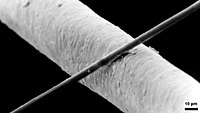
Photo from wikipedia
Abstract A round hollow steel section (HSS) is generally used in a wind turbine tower column. Experimental studies on the cyclic flexural behavior of round HSS columns with large diameter-to-thickness… Click to show full abstract
Abstract A round hollow steel section (HSS) is generally used in a wind turbine tower column. Experimental studies on the cyclic flexural behavior of round HSS columns with large diameter-to-thickness (D/t) ratios are very limited. Three steel round HSS column specimens with a D/t ratio of 240 were planned for tests. The specimens, made from ASTM A36 steel, had a clear height of 4390 mm, diameter of 1440 mm and thickness of 6 mm. In addition, one specimen was wrapped with the Glass Fiber Reinforced Polymer (GFRP) material. Specimen 1 was tested under an increasingly monotonic loading, and Specimens 2 and 3 were tested under an increasingly cyclic loading. Specimens 1 and 2 exhibited inward local buckling at a drift angle of 0.0025 rad.; Specimen 3 with GFRP wrapping at the bottom end exhibited inward local buckling at a drift angle of 0.003 rad., slightly later than the timing when the local buckling occurred in Specimens 1 and 2. Test results indicated that the ductility of Specimen 1 under the monotonic loading is larger than that of Specimens 2 and 3 under the cyclic loading due to slower strength degradation. Specimen 2 has a ductility of 1.02–1.65 before the lateral load decreases more than 10%. The maximum flexural strength of the GFRP-wrapped column increases 6%–10% compared to that without GFRP wrapping. The AISC (2016) and EN1993-1-6 (2017) standards reasonably predict the flexural strength of specimens, but the ASME (2006) and ASCE (2011) standards underestimate the flexural strength by 18%–25%. Nonlinear time–history analyses were conducted on a 10-MW wind turbine tower to develop a cyclic displacement protocol for the tests.
Journal Title: Thin-walled Structures
Year Published: 2021
Link to full text (if available)
Share on Social Media: Sign Up to like & get
recommendations!